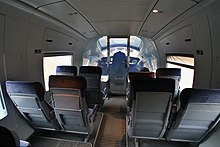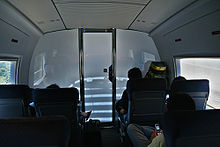Smart glass
As intelligent glass ( English Smart Glass ) are tintable glazing referred whose light transmittance by applying an electrical voltage ( electrochromism ), changing light conditions ( photochromism ) or heat ( thermochromism changed). Various technologies and fields of application are summarized under the generic term intelligent glass . Depending on the design, these glasses can serve as sun protection (glass remains transparent) or act as a privacy screen (glass becomes opaque ).
Electrochromic glass
Structure and functionality
Electrochromic glass uses the property of electrochromic materials to change the light transmission depending on the applied DC voltage . By applying a low voltage of 3-5 volts, a bluish color is achieved. When electrical charges are transferred to a microscopically thin coating ( e.g. tungsten trioxide , polyaniline ), it becomes optically active and changes its color. This process can take anywhere from a few seconds to several minutes. If the polarity of the voltage is changed, the glass becomes transparent again. The glass only needs a current of approx. 2 amps during the coloring phase or when creating complete transparency. If no voltage is applied, the glass retains its current color.
Depending on the application, the voltage can be regulated manually or automatically, for example by sensors that measure the brightness.
Application examples
- In vehicle construction as a roof window, for example in the Ferrari 575 M Superamerica
- Rearview mirrors dimming automatically or at the push of a button
- Building glazing for temperature regulation or as UV protection
Thermochromic glass
Structure and functionality
Thermochromic glass uses the property of thermochromic materials to change their light absorption depending on the temperature. When exposed to sunlight, the thermochromic glasses heat up and become colored. If the sunlight subsides, the thermochromic glasses cool down again and discolor. Thermochromic glasses are usually designed as laminated glasses , ie two panes of glass are laminated together with a special film. This film contains the thermochromic substances.
Application examples
- As switchable thermochromic sun protection glass
LC glass
LC glass or PDLC glass for liquid crystal or polymer dispersed liquid crystal becomes transparent when an electrical voltage is applied and functions similarly to an LCD . This process is reversible .
Structure and functionality
LC-glasses are based on a polymer - liquid crystal film which is embedded between two flat glass panes and is connected to a voltage source. The randomly oriented liquid crystal molecules are located within the solid polymer. The incident light is scattered by them and the pane is opaque , so it looks like frosted glass.
When an electrical voltage is applied, the liquid crystal molecules arrange themselves in the electrical field - the glass becomes transparent to the eye. At an oblique viewing angle, the effect causes a slight clouding for the viewer.
When the voltage is removed, the liquid crystal molecules are disordered again and the pane becomes opaque again and thus almost completely opaque. These glasses are primarily suitable as privacy protection, but not as sun protection.
costs
The price is between 1700 and 2000 € / m² including installation.
Application examples
- Partition wall systems for open plan offices
- The lounge in ICE 3 and ICE T trains is separated from the driver's cab by LC glass .
- Options for the Maybach 57, 62 and Landaulet
- The side windows of the gondola lift of the Bukit Panjang LRT are made of LC glass and become opaque when they drive very close to residential buildings.
See also
Individual evidence
- ↑ Construction network knowledge, article on the topic of sun protection glazing ( Memento of the original from February 27, 2010 in the Internet Archive ) Info: The archive link was inserted automatically and has not yet been checked. Please check the original and archive link according to the instructions and then remove this notice. , last accessed March 30, 2010
- ↑ Description of Intraselect, an electrochromic glass , last accessed on March 30, 2010.
- ^ Page from Saint Gobain, manufacturer of electrochromic glazing ( Memento of November 14, 2008 in the Internet Archive ), last accessed March 30, 2010.
- ↑ site of Ferrari (Engl.)
- ↑ Gesimat GmbH Germany, manufacturer of thermochromic glazing
- ↑ Construction network knowledge ( memento of the original from March 7, 2011 in the Internet Archive ) Info: The archive link was automatically inserted and not yet checked. Please check the original and archive link according to the instructions and then remove this notice. , last accessed March 30, 2010.
- ↑ Information from the supplier Polytron ( Memento from December 28, 2010 in the Internet Archive ), last accessed March 30, 2010.
Web links
- J. Dittrich: Electrochromic glasses. (PDF file; approx. 775 kB)
- Publication "Switchable and controllable glazing" by FIZ Karlsruhe ( Memento from June 16, 2014 in the Internet Archive ) (PDF file; approx. 950 kB)
- GDCh Wochenschau: Intelligent windows and automatically dimming mirrors: Electrochromic makes it possible , 2006
- Electric current as a blind on faz.net



